Yuqi Lin
HiCache: Training-free Acceleration of Diffusion Models via Hermite Polynomial-based Feature Caching
Aug 23, 2025Abstract:Diffusion models have achieved remarkable success in content generation but suffer from prohibitive computational costs due to iterative sampling. While recent feature caching methods tend to accelerate inference through temporal extrapolation, these methods still suffer from server quality loss due to the failure in modeling the complex dynamics of feature evolution. To solve this problem, this paper presents HiCache, a training-free acceleration framework that fundamentally improves feature prediction by aligning mathematical tools with empirical properties. Our key insight is that feature derivative approximations in Diffusion Transformers exhibit multivariate Gaussian characteristics, motivating the use of Hermite polynomials-the potentially theoretically optimal basis for Gaussian-correlated processes. Besides, We further introduce a dual-scaling mechanism that ensures numerical stability while preserving predictive accuracy. Extensive experiments demonstrate HiCache's superiority: achieving 6.24x speedup on FLUX.1-dev while exceeding baseline quality, maintaining strong performance across text-to-image, video generation, and super-resolution tasks. Core implementation is provided in the appendix, with complete code to be released upon acceptance.
SAMRefiner: Taming Segment Anything Model for Universal Mask Refinement
Feb 10, 2025



Abstract:In this paper, we explore a principal way to enhance the quality of widely pre-existing coarse masks, enabling them to serve as reliable training data for segmentation models to reduce the annotation cost. In contrast to prior refinement techniques that are tailored to specific models or tasks in a close-world manner, we propose SAMRefiner, a universal and efficient approach by adapting SAM to the mask refinement task. The core technique of our model is the noise-tolerant prompting scheme. Specifically, we introduce a multi-prompt excavation strategy to mine diverse input prompts for SAM (i.e., distance-guided points, context-aware elastic bounding boxes, and Gaussian-style masks) from initial coarse masks. These prompts can collaborate with each other to mitigate the effect of defects in coarse masks. In particular, considering the difficulty of SAM to handle the multi-object case in semantic segmentation, we introduce a split-then-merge (STM) pipeline. Additionally, we extend our method to SAMRefiner++ by introducing an additional IoU adaption step to further boost the performance of the generic SAMRefiner on the target dataset. This step is self-boosted and requires no additional annotation. The proposed framework is versatile and can flexibly cooperate with existing segmentation methods. We evaluate our mask framework on a wide range of benchmarks under different settings, demonstrating better accuracy and efficiency. SAMRefiner holds significant potential to expedite the evolution of refinement tools. Our code is available at https://github.com/linyq2117/SAMRefiner.
GATE OpenING: A Comprehensive Benchmark for Judging Open-ended Interleaved Image-Text Generation
Dec 01, 2024Abstract:Multimodal Large Language Models (MLLMs) have made significant strides in visual understanding and generation tasks. However, generating interleaved image-text content remains a challenge, which requires integrated multimodal understanding and generation abilities. While the progress in unified models offers new solutions, existing benchmarks are insufficient for evaluating these methods due to data size and diversity limitations. To bridge this gap, we introduce GATE OpenING (OpenING), a comprehensive benchmark comprising 5,400 high-quality human-annotated instances across 56 real-world tasks. OpenING covers diverse daily scenarios such as travel guide, design, and brainstorming, offering a robust platform for challenging interleaved generation methods. In addition, we present IntJudge, a judge model for evaluating open-ended multimodal generation methods. Trained with a novel data pipeline, our IntJudge achieves an agreement rate of 82. 42% with human judgments, outperforming GPT-based evaluators by 11.34%. Extensive experiments on OpenING reveal that current interleaved generation methods still have substantial room for improvement. Key findings on interleaved image-text generation are further presented to guide the development of next-generation models. The OpenING is open-sourced at https://opening-benchmark.github.io.
MMT-Bench: A Comprehensive Multimodal Benchmark for Evaluating Large Vision-Language Models Towards Multitask AGI
Apr 24, 2024



Abstract:Large Vision-Language Models (LVLMs) show significant strides in general-purpose multimodal applications such as visual dialogue and embodied navigation. However, existing multimodal evaluation benchmarks cover a limited number of multimodal tasks testing rudimentary capabilities, falling short in tracking LVLM development. In this study, we present MMT-Bench, a comprehensive benchmark designed to assess LVLMs across massive multimodal tasks requiring expert knowledge and deliberate visual recognition, localization, reasoning, and planning. MMT-Bench comprises $31,325$ meticulously curated multi-choice visual questions from various multimodal scenarios such as vehicle driving and embodied navigation, covering $32$ core meta-tasks and $162$ subtasks in multimodal understanding. Due to its extensive task coverage, MMT-Bench enables the evaluation of LVLMs using a task map, facilitating the discovery of in- and out-of-domain tasks. Evaluation results involving $30$ LVLMs such as the proprietary GPT-4V, GeminiProVision, and open-sourced InternVL-Chat, underscore the significant challenges posed by MMT-Bench. We anticipate that MMT-Bench will inspire the community to develop next-generation multimodal foundation models aimed at achieving general-purpose multimodal intelligence.
UniHDA: Towards Universal Hybrid Domain Adaptation of Image Generators
Jan 23, 2024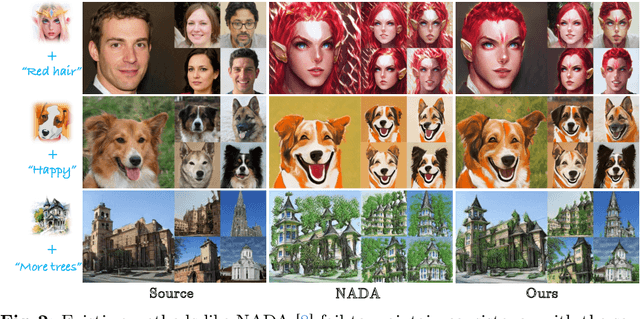
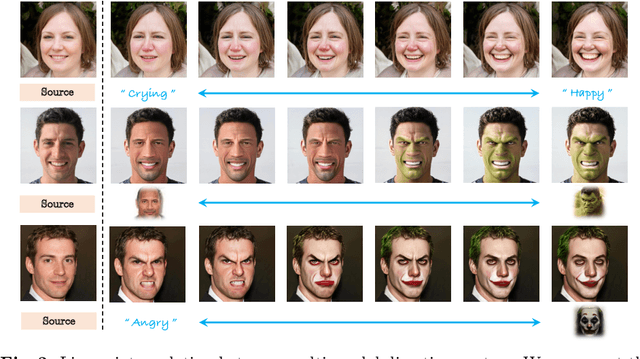
Abstract:Generative domain adaptation has achieved remarkable progress, enabling us to adapt a pre-trained generator to a new target domain. However, existing methods simply adapt the generator to a single target domain and are limited to a single modality, either text-driven or image-driven. Moreover, they are prone to overfitting domain-specific attributes, which inevitably compromises cross-domain consistency. In this paper, we propose UniHDA, a unified and versatile framework for generative hybrid domain adaptation with multi-modal references from multiple domains. We use CLIP encoder to project multi-modal references into a unified embedding space and then linear interpolate the direction vectors from multiple target domains to achieve hybrid domain adaptation. To ensure the cross-domain consistency, we propose a novel cross-domain spatial structure (CSS) loss that maintains detailed spatial structure information between source and target generator. Experiments show that the adapted generator can synthesise realistic images with various attribute compositions. Additionally, our framework is versatile to multiple generators, \eg, StyleGAN2 and Diffusion Models.
TagCLIP: A Local-to-Global Framework to Enhance Open-Vocabulary Multi-Label Classification of CLIP Without Training
Dec 20, 2023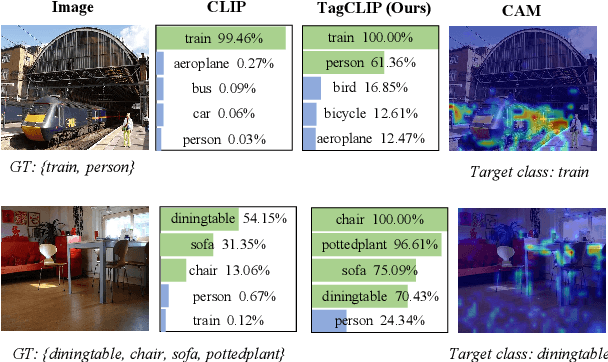

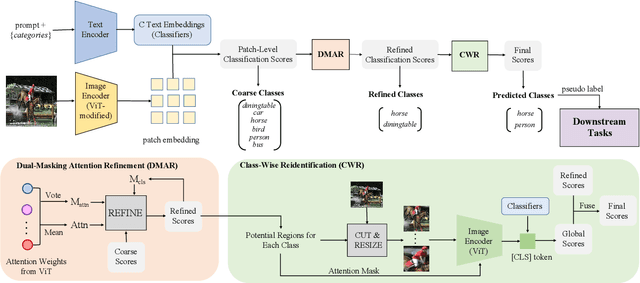
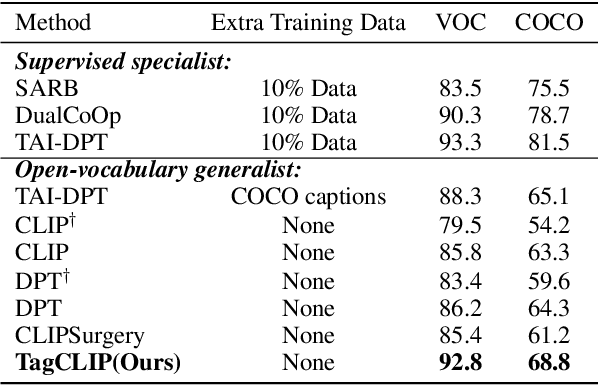
Abstract:Contrastive Language-Image Pre-training (CLIP) has demonstrated impressive capabilities in open-vocabulary classification. The class token in the image encoder is trained to capture the global features to distinguish different text descriptions supervised by contrastive loss, making it highly effective for single-label classification. However, it shows poor performance on multi-label datasets because the global feature tends to be dominated by the most prominent class and the contrastive nature of softmax operation aggravates it. In this study, we observe that the multi-label classification results heavily rely on discriminative local features but are overlooked by CLIP. As a result, we dissect the preservation of patch-wise spatial information in CLIP and proposed a local-to-global framework to obtain image tags. It comprises three steps: (1) patch-level classification to obtain coarse scores; (2) dual-masking attention refinement (DMAR) module to refine the coarse scores; (3) class-wise reidentification (CWR) module to remedy predictions from a global perspective. This framework is solely based on frozen CLIP and significantly enhances its multi-label classification performance on various benchmarks without dataset-specific training. Besides, to comprehensively assess the quality and practicality of generated tags, we extend their application to the downstream task, i.e., weakly supervised semantic segmentation (WSSS) with generated tags as image-level pseudo labels. Experiments demonstrate that this classify-then-segment paradigm dramatically outperforms other annotation-free segmentation methods and validates the effectiveness of generated tags. Our code is available at https://github.com/linyq2117/TagCLIP.
Few-shot Hybrid Domain Adaptation of Image Generators
Oct 30, 2023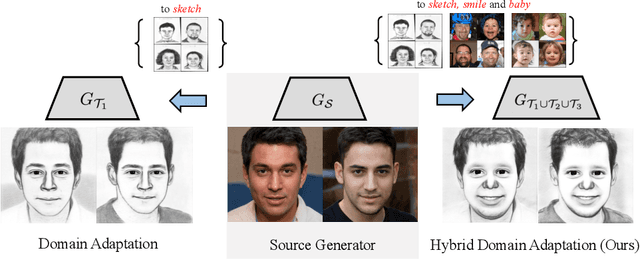
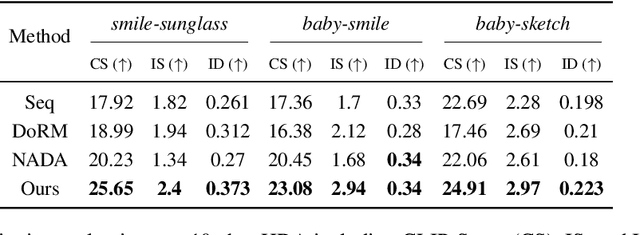


Abstract:Can a pre-trained generator be adapted to the hybrid of multiple target domains and generate images with integrated attributes of them? In this work, we introduce a new task -- Few-shot Hybrid Domain Adaptation (HDA). Given a source generator and several target domains, HDA aims to acquire an adapted generator that preserves the integrated attributes of all target domains, without overriding the source domain's characteristics. Compared with Domain Adaptation (DA), HDA offers greater flexibility and versatility to adapt generators to more composite and expansive domains. Simultaneously, HDA also presents more challenges than DA as we have access only to images from individual target domains and lack authentic images from the hybrid domain. To address this issue, we introduce a discriminator-free framework that directly encodes different domains' images into well-separable subspaces. To achieve HDA, we propose a novel directional subspace loss comprised of a distance loss and a direction loss. Concretely, the distance loss blends the attributes of all target domains by reducing the distances from generated images to all target subspaces. The direction loss preserves the characteristics from the source domain by guiding the adaptation along the perpendicular to subspaces. Experiments show that our method can obtain numerous domain-specific attributes in a single adapted generator, which surpasses the baseline methods in semantic similarity, image fidelity, and cross-domain consistency.
Self-supervised and Weakly Supervised Contrastive Learning for Frame-wise Action Representations
Dec 23, 2022
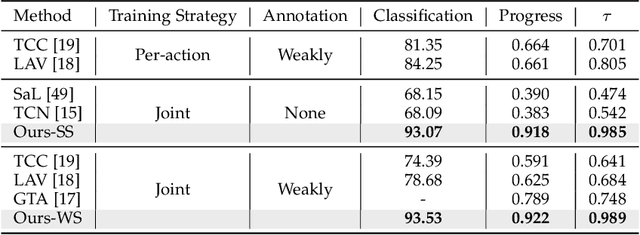
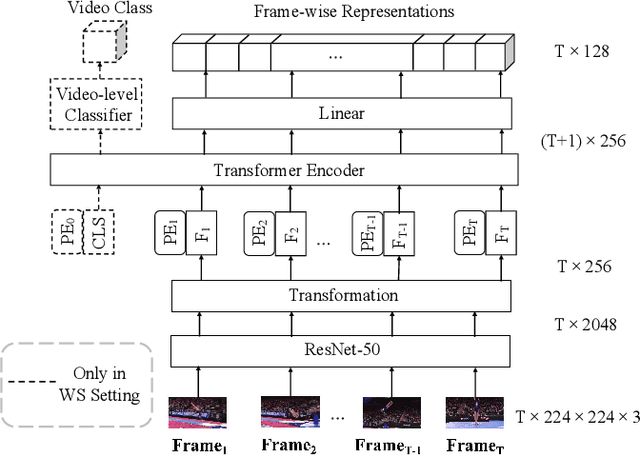
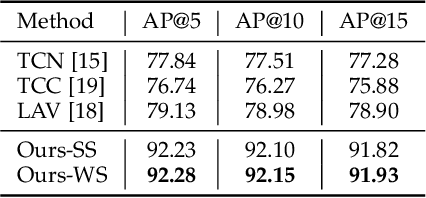
Abstract:Previous work on action representation learning focused on global representations for short video clips. In contrast, many practical applications, such as video alignment, strongly demand learning the intensive representation of long videos. In this paper, we introduce a new framework of contrastive action representation learning (CARL) to learn frame-wise action representation in a self-supervised or weakly-supervised manner, especially for long videos. Specifically, we introduce a simple but effective video encoder that considers both spatial and temporal context by combining convolution and transformer. Inspired by the recent massive progress in self-supervised learning, we propose a new sequence contrast loss (SCL) applied to two related views obtained by expanding a series of spatio-temporal data in two versions. One is the self-supervised version that optimizes embedding space by minimizing KL-divergence between sequence similarity of two augmented views and prior Gaussian distribution of timestamp distance. The other is the weakly-supervised version that builds more sample pairs among videos using video-level labels by dynamic time wrapping (DTW). Experiments on FineGym, PennAction, and Pouring datasets show that our method outperforms previous state-of-the-art by a large margin for downstream fine-grained action classification and even faster inference. Surprisingly, although without training on paired videos like in previous works, our self-supervised version also shows outstanding performance in video alignment and fine-grained frame retrieval tasks.
CLIP is Also an Efficient Segmenter: A Text-Driven Approach for Weakly Supervised Semantic Segmentation
Dec 20, 2022Abstract:Weakly supervised semantic segmentation (WSSS) with image-level labels is a challenging task in computer vision. Mainstream approaches follow a multi-stage framework and suffer from high training costs. In this paper, we explore the potential of Contrastive Language-Image Pre-training models (CLIP) to localize different categories with only image-level labels and without any further training. To efficiently generate high-quality segmentation masks from CLIP, we propose a novel framework called CLIP-ES for WSSS. Our framework improves all three stages of WSSS with special designs for CLIP: 1) We introduce the softmax function into GradCAM and exploit the zero-shot ability of CLIP to suppress the confusion caused by non-target classes and backgrounds. Meanwhile, to take full advantage of CLIP, we re-explore text inputs under the WSSS setting and customize two text-driven strategies: sharpness-based prompt selection and synonym fusion. 2) To simplify the stage of CAM refinement, we propose a real-time class-aware attention-based affinity (CAA) module based on the inherent multi-head self-attention (MHSA) in CLIP-ViTs. 3) When training the final segmentation model with the masks generated by CLIP, we introduced a confidence-guided loss (CGL) to mitigate noise and focus on confident regions. Our proposed framework dramatically reduces the cost of training for WSSS and shows the capability of localizing objects in CLIP. Our CLIP-ES achieves SOTA performance on Pascal VOC 2012 and MS COCO 2014 while only taking 10% time of previous methods for the pseudo mask generation. Code is available at https://github.com/linyq2117/CLIP-ES.
 Add to Chrome
Add to Chrome Add to Firefox
Add to Firefox Add to Edge
Add to Edge